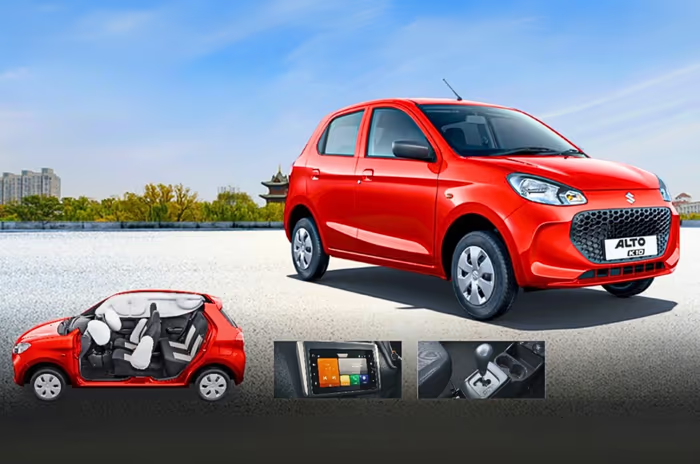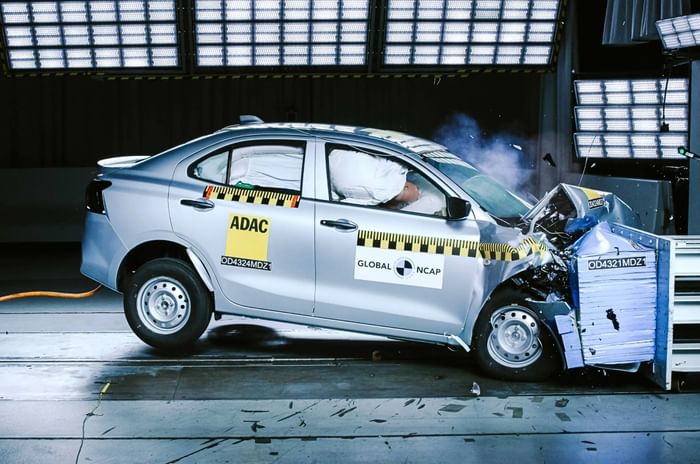Maruti Suzuki chairman R.C. Bhargava has confirmed at the previous earning’s call that all cars from the brand will have 6 airbags as standard before 2025 ends. “We will be having 6 airbags in virtually all our cars this year,” he said. “So from the safety point of view, the government was very keen that 6 airbags should be in all cars. We will implement this desire of the government and that will help us,” Maruti’s chairman explained.
- Maruti Baleno and Fronx only get 6 airbags on higher variants
- Maruti Ertiga, XL6, Ignis, S-Presso prices to increase with 6 airbags update
- 6 airbags announcement indicates Maruti’s increased focus on safety
Maruti cars without 6 airbags standards
6 airbags update to increase prices of 6 more Maruti cars

The Alto K10 is currently the most affordable car with 6 airbags
Maruti Suzuki has been upgrading its line-up with 6 airbags, with the most recent recipients being the Eeco, Wagon R, Alto K10, Brezza, and Celerio, all of which came this year. There are 6 Maruti cars at the moment that do not get 6 airbags standard across the range – the Baleno, Fronx, Ignis, Ertiga, XL6 and S-Presso.
As the Fronx and Baleno do get side and curtain airbags on higher variants, prices for those are unlikely to change, though the entry-level trims will cost more than they currently do; the Fronx range currently starts at Rs 7.55 lakh, while Baleno prices start at Rs 6.70 lakh. Prices for the Ertiga, XL6, Ignis and S-Presso will also increase with the update, as they did for the other Maruti models; the Celerio saw the biggest hike of up to Rs 32,500.
Maruti’s increased focus on safety
Increase in safety comes with an increase in price, which affects sales

The Dzire became the first Maruti to get a 5-star crash test rating.
Interestingly, the implementation of 6 airbags across its model range is something of a contradictory stance for Maruti. When the Indian Government had planned to institute 6 airbags as standard on all cars sold in the country, the brand had reservations, due to the increase in cost. Speaking to our sister publication Autocar Professional last year, Bhargava had said, “The volumes in the entry-level segment have been declining over the last couple of years, and if the costs of these products go up further, the sales will decline even more.”
This statement has been corroborated by the fact that Maruti Suzuki saw small car sales falling by 9 percent during the previous year. Bhargava pointed to income distribution as a critical factor limiting growth in the affordable end of the market. “Only around 12 percent of households in India earn over Rs 12 lakh annually and can consider buying a car priced at Rs 10 lakh or more,” he said. “Car buying in India is largely restricted to this 12 percent. How can you expect growth when 88 percent of the country is at a level where they cannot afford these cars?”
Fourth-gen Dzire is the first Maruti to get a 5-star GNCAP rating
Still, Maruti Suzuki is visibly making efforts to showcase its cars as safe; that the fourth-gen Maruti Dzire scored a 5-star Global NCAP rating bodes well for the brand. Unfortunately, a number of Maruti cars – such as the Alto K10 (2 stars), Wagon R (1-star), S-Presso (1-star) and Ignis (1-star) – all received poor safety ratings from Global NCAP, which has hampered the image of the brand. It remains to be seen how much safer will the models become after the 6 airbags update.
Also see:
Cars under Rs 10 lakh with 6 airbags
Tata Nexon EV 5-star BNCAP safety rating extended to 45kWh variants

